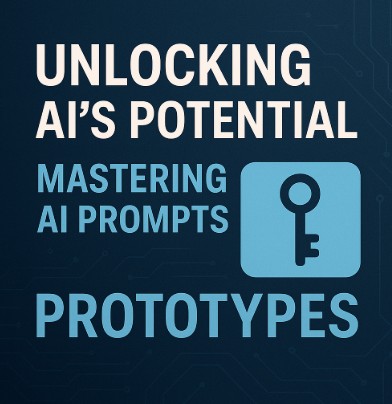The world of artificial intelligence is rapidly evolving, and harnessing its power effectively is crucial for staying ahead in today’s competitive landscape. For developers, DevOps engineers, and anyone working with AI, understanding how to craft effective AI prompts prototypes is no longer a luxury—it’s a necessity. This comprehensive guide will equip you with the knowledge and practical techniques to build with AI like the pros, transforming complex ideas into tangible, working applications. We’ll explore the intricacies of AI prompts and prototypes, demonstrating how strategic prompt engineering and iterative prototyping can dramatically improve the efficiency and effectiveness of your AI projects.
Table of Contents
Understanding the Power of AI Prompts
The foundation of any successful AI project lies in the quality of its prompts. An AI prompt is essentially the instruction or query you provide to an AI model. The specificity and clarity of your prompt directly impact the accuracy and relevance of the model’s output. Poorly constructed prompts can lead to ambiguous results, wasted computational resources, and ultimately, project failure. Effective prompt engineering requires a deep understanding of the AI model’s capabilities and limitations, as well as a clear articulation of your desired outcome.
Crafting Effective AI Prompts: Best Practices
- Be Specific: Avoid vague language. Clearly define your requirements and desired format.
- Provide Context: Give the AI model sufficient background information to understand the task.
- Iterate and Refine: Experiment with different prompts and analyze the results to optimize your approach.
- Use Keywords Strategically: Incorporate relevant keywords to guide the AI towards the desired output.
- Specify Output Format: Indicate the preferred format (e.g., JSON, text, code).
Example: Generating Code with AI Prompts
Let’s say you need to generate a Python function to calculate the factorial of a number. A poorly constructed prompt might be: “Write a factorial function.” A more effective prompt would be: “Write a Python function called `factorial` that takes an integer as input and returns its factorial using recursion. The function should handle edge cases such as negative input by raising a ValueError.” This detailed prompt provides context, specifies the programming language, function name, and desired behavior, increasing the likelihood of obtaining the correct code.
The Crucial Role of Prototyping in AI Development
Prototyping is an iterative process of building and testing rudimentary versions of your AI system. It’s a vital step in validating your ideas, identifying potential issues early on, and ensuring that your final product meets its intended purpose. Prototypes allow you to experiment with different algorithms, architectures, and data sets before committing significant resources to a full-scale implementation.
Types of AI Prototypes
- Proof-of-Concept (POC): Demonstrates the feasibility of a specific technique or approach.
- Minimum Viable Product (MVP): A basic version of the system with core functionality.
- High-Fidelity Prototype: A near-complete representation of the final product.
Iterative Development with Prototypes
The prototyping process is not a linear one. It involves cycles of building, testing, evaluating, and refining. Feedback from testing informs the design and implementation of subsequent iterations, leading to a more robust and effective final product. This iterative approach is particularly important in AI development, where unexpected challenges and limitations of the models can arise.
Building with AI Prompts and Prototypes: A Practical Approach
Let’s combine prompt engineering and prototyping to build a simple AI-powered text summarizer. We will use a large language model (LLM) like GPT-3 (or its open-source alternatives). First, we’ll define our requirements and create a prototype using a few carefully crafted AI prompts and prototypes.
Step 1: Define Requirements
Our summarizer should take a long text as input and generate a concise summary. The summary should be accurate, coherent, and preserve the key ideas of the original text.
Step 2: Craft the Initial Prompt
Our first prompt might be: “Summarize the following text: [Insert Text Here]” This is a basic prompt; we’ll iterate on this.
Step 3: Iterative Prompt Refinement
After testing with various texts, we might find that the summaries are too long or lack key details. We can refine the prompt by adding constraints: “Summarize the following text in 100 words or less, focusing on the main points and conclusions: [Insert Text Here]”
Step 4: Prototype Development and Testing
We can build a simple prototype using a Python script and an LLM API. This prototype allows us to test different prompts and evaluate the quality of the generated summaries. The feedback loop is crucial here. We continuously refine our prompts based on the prototype’s output.
# Example Python code (requires an LLM API key)
import openai
openai.api_key = "YOUR_API_KEY" # Replace with your actual API key
def summarize_text(text, max_tokens=100):
"""
Summarizes the given text using the OpenAI API.
Args:
text (str): The input text to be summarized.
max_tokens (int): The maximum number of tokens for the summary.
Returns:
str: The summarized text.
"""
response = openai.Completion.create(
engine="text-davinci-003", # Or another suitable engine like "gpt-3.5-turbo-instruct"
prompt=f"Summarize the following text in {max_tokens} words or less, focusing on the main points and conclusions: {text}",
max_tokens=max_tokens,
n=1,
stop=None,
temperature=0.5,
)
summary = response.choices[0].text.strip()
return summary
# Example usage
long_text = """
The quick brown fox jumps over the lazy dog. This sentence is often used to
demonstrate various aspects of language, including typography, keyboard layouts,
and computer programming. It is a pangram, meaning it contains every letter
of the alphabet at least once. Pangrams are useful for testing fonts and
typewriters, ensuring all characters are represented. In software development,
they can be used for quick checks of text rendering or input handling.
"""
summary = summarize_text(long_text, max_tokens=50) # Requesting a summary of up to 50 tokens
print(summary)
AI Prompts and Prototypes: Advanced Techniques
As you gain experience, you can explore more advanced techniques for prompt engineering and prototyping. These include:
- Few-shot learning: Providing the model with a few examples of input-output pairs to guide its behavior.
- Chain-of-thought prompting: Guiding the model to reason step-by-step to arrive at the solution.
- Prompt chaining: Breaking down a complex task into smaller subtasks, each addressed with a separate prompt.
- Using external knowledge sources: Incorporating data from external databases or knowledge graphs into the prompts.
Frequently Asked Questions
Q1: What are the common pitfalls of AI prompt engineering?
Common pitfalls include vague prompts, lack of context, unrealistic expectations, and neglecting to iterate and refine prompts based on feedback.
Q2: How do I choose the right prototyping method for my AI project?
The choice depends on your project’s scope, timeline, and resources. Proof-of-concept prototypes are suitable for early-stage exploration, while MVPs are better for testing core functionality.
Q3: What tools and technologies are useful for building AI prototypes?
Tools like Jupyter notebooks, cloud computing platforms (AWS, GCP, Azure), and various AI model APIs are widely used for building and testing AI prototypes.
Q4: How important is testing in the AI prompts and prototypes development lifecycle?
Testing is paramount. Thorough testing ensures the accuracy, reliability, and robustness of your AI system, identifying and addressing potential biases, errors, or limitations early on.

Conclusion
Mastering AI prompts and prototypes is essential for anyone aiming to leverage the full potential of AI. By carefully crafting your prompts, employing iterative prototyping, and embracing a continuous feedback loop, you can significantly improve the efficiency and effectiveness of your AI projects. Remember that effective AI prompts and prototypes are not a one-time effort; they require continuous refinement and adaptation throughout the development lifecycle. Embrace experimentation, analyze your results, and refine your approach to unlock the true power of AI in your endeavors.
For further reading on Large Language Models, refer to the OpenAI documentation and for more on model prompt engineering, explore resources from research papers on the subject. Another valuable resource is the Hugging Face Model Hub which showcases a variety of pre-trained models and tools. Thank you for reading the DevopsRoles page!
